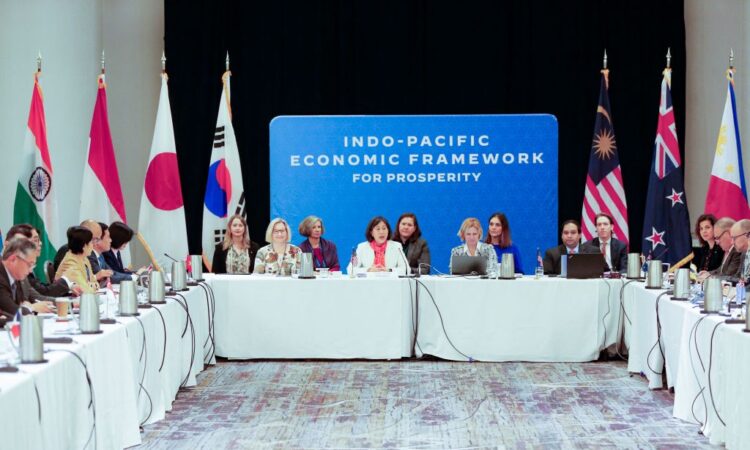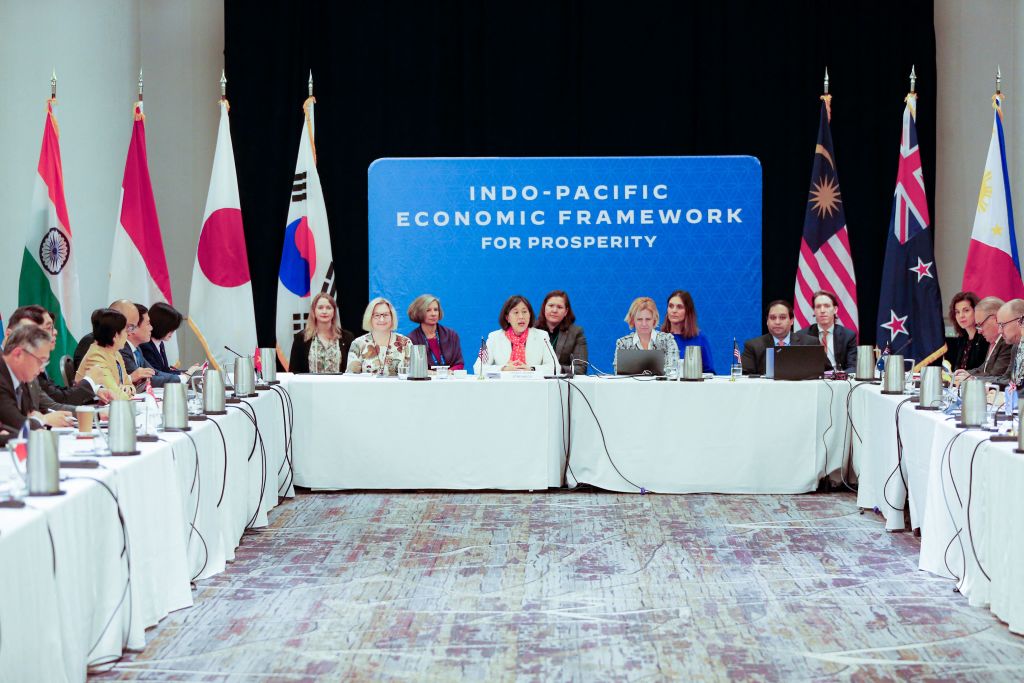

With the signing of the Indo-Pacific Economic Framework supply-chain agreement in November last year, on the sidelines of the APEC summit in San Francisco, the United States took a major step towards establishing a regional economic architecture under its leadership, despite the initial hiccups that followed the IPEF’s announcement more than a year ago.
By fostering collaboration among IPEF member states, the agreement aims to enhance the resilience, efficiency, transparency, diversity, security and inclusivity of supply chains in the Indo-Pacific. Washington has asserted that this will not only bolster the competitiveness of the region’s supply chains but also reduce costs, all while ensuring a stable supply of critical goods in times of crisis. The agreement encourages the parties to explore diversification strategies, streamline trade through regulatory enhancements and optimise logistics.
The aims of the agreement are to pre-empt, prevent and proactively manage disruptions to global supply chains. Given the supply-chain problems witnessed during the peak of the Covid-19 pandemic, which significantly affected the US economy and led to inflationary pressures, this is a prudent move. Economists have argued that around 60% of the surge in US inflation in early 2021 can be attributed to supply-chain constraints. However, the agreement’s implications extend beyond addressing supply-chain disruptions.
It’s evident that the IPEF seeks to reduce member countries’ dependence on specific sources, prompting parties to assess their level of reliance on individual suppliers, countries, regions and geographic locations. While some commentators have viewed this as a US attempt to shift regional trade away from China, it can also be seen as a bid to secure US access to the Asian regional supply chain. Some also speculate that it could be a strategic move in anticipation of strained US–China trade relations.
The IPEF’s emphasis on transparency and institutionalisation, and the ensuing commitments and obligations, is designed to safeguard the US’s economic interests, particularly in critical sectors and essential commodities. The agreement establishes a Supply Chain Council tasked to ‘assess capabilities, map supply chains, identify bottlenecks, and explore options for diversification of concentrated sources of supply for sectors and goods of shared interest’. It also sets up a Supply Chain Crisis Response Network requiring partners to establish channels and mechanisms to prepare for, prevent and ‘respond to, mitigate, and recover from the impacts of a supply chain disruption’. These measures are designed to ensure that the US retains access to vital sectors and goods, regardless of unforeseen circumstances.
Setting these reasons aside, the drive to strengthen supply chains and engage various stakeholders—including industry, academia, the public sector and non-government organisations—should be viewed positively. These efforts are poised to result in more competitive and resilient supply chains.
In addition, the agreement incorporates provisions to institutionalise the protection of labour rights. It establishes a tripartite IPEF Labor Rights Advisory Board, comprising government, worker and employer representatives, tasked with identifying and addressing labour rights shortcomings. Arrangements of this sort are present in countries like Singapore and Malaysia, thus making it more acceptable than the usual route for addressing such concerns under a traditional free-trade agreement.
While much of the agreement employs broad language and non-binding terms (for example, the word ‘intend’ appears often), several commitments and obligations mirror those found in the Comprehensive and Progressive Agreement for Trans-Pacific Partnership, to which many IPEF member countries are signatories. Notably, there’s no mention of a dispute-settlement mechanism, a feature that could alleviate concerns about the agreement’s enforceability. Nonetheless, the creation of the three governing bodies implies a level of discipline not typically associated with APEC’s more relaxed approach.
Leadership under the agreement will be critical, since the process will be driven by a rotating chairmanship. While the current US administration appears committed to this initiative, there’s no guarantee that this position will be maintained. Donald Trump has already vowed to kill the deal if he wins the presidential election in November. There are also questions about the level of commitment of other member nations. They may not show it, but for those IPEF members that are also parties to the CPTPP, having the US involved is advantageous. The main reason for some of them joining the IPEF was the hope that it would lead to the US rejoining the CPTPP.
The challenge now lies in making trade a compelling domestic issue for them—a problem that the US itself faces. Some have suggested that the recent U-turn by the US on the IPEF digital trade negotiations reflects a retreat towards nativist protectionism. The US decision to abort plans to announce a partial trade agreement on enforceable trade rules is also seen as a sign of ‘the great American no-show’. But we shouldn’t set off the alarm bells prematurely. Washington’s reluctance to discuss some key digital trade aspects and its postponement of talks as a result doesn’t signify a withdrawal from IPEF.
The provisions in question, some of which have faced criticism for potentially granting unrestricted authority to large technology corporations, might find favour among several members of the IPEF, especially those that seek the ability to oversee these corporations and manage data transfers. Similar measures have been implemented within the World Trade Organization as well, indirectly indicating that the current regulations in the e-commerce agreement are considered satisfactory. This seems to attest more to support for the existing architecture than a critique against it. Nevertheless, we can be forgiven if we have held such suspicions thanks largely to the US’s own actions in recent years.
Whether the IPEF will cement the US as an important stakeholder in the Asian multilateral regional economic order will be determined primarily by the level of sustained interest and commitment from Washington. The Trump administration’s inward-looking policies and decision to pull out from the Trans-Pacific Partnership, mirrored in many ways by the Biden administration’s reluctance to join the CPTPP, have raised questions about the US’s credibility as a champion of free and open multilateral trade. The IPEF has the potential to address such concerns. The successful conclusion of the ASEAN-led 15-member Regional Comprehensive Economic Partnership, which also involves China and Japan, put China in a more confident position vis-à-vis the US in the region.
With the IPEF still at a nascent stage, it would be challenging for the US to mould its fine print and wield it directly against China. However, the IPEF stands a good chance to position itself as one of the key pillars of the Asian multilateral regional economic order in a scenario where China adopts more insular trade policies under its ‘dual circulation’ strategy. While that strategy may not be entirely inward-looking, its goal of protecting China from global economic headwinds by making it more self-reliant could entail localisation of supply chains within China. This could be the IPEF’s (and the US’s) moment to rechampion free and liberal trade values—provided Washington walks the talk.






